- Home
- Bill Bryson
I'm a Stranger Here Myself Page 6
I'm a Stranger Here Myself Read online
Page 6
So there I was down on my knees unwrapping pieces of foil and peering cautiously into Tupperware containers when I came across an interesting product called a breakfast pizza. I examined it with a kind of rueful fondness, as you might regard an old photograph of yourself dressed in clothes that you cannot believe you ever thought were stylish. The breakfast pizza, you see, represented the last surviving relic of a bout of very serious retail foolishness on my part.
Some weeks ago I announced to my wife that I was going to the supermarket with her next time she went because the stuff she kept bringing home was—how can I put this?—not fully in the spirit of American eating. I mean, here we were living in a paradise of junk food—the country that gave the world cheese in a spray can—and she kept bringing home healthy stuff like fresh broccoli and packets of Swedish crispbread.
It was because she was English, of course. She didn’t really understand the rich, unrivaled possibilities for greasiness and goo that the American diet offers. I longed for artificial bacon bits, melted cheese in a shade of yellow unknown to nature, and creamy chocolate fillings, sometimes all in the same product. I wanted food that squirts when you bite into it or plops onto your shirt front in such gross quantities that you have to rise very, very carefully from the table and sort of limbo over to the sink to clean yourself up.
So I accompanied her to the supermarket and while she was off squeezing melons and pricing shiitake mushrooms, I made for the junk-food section—which was essentially all the rest of the store. Well, it was heaven.
The breakfast cereals alone could have occupied me for most of the afternoon. There must have been two hundred types. Every possible substance that could be dried, puffed, and coated with sugar was there. The most immediately arresting was a cereal called Cookie Crisp, which tried to pretend it was a nutritious breakfast but was really just chocolate chip cookies that you put in a bowl and ate with milk. Brilliant.
Also of note were cereals called Peanut Butter Crunch, Cinnamon Mini Buns, Count Chocula (“with Monster Marshmallows”), and a particularly hardcore offering called Cookie Blast Oat Meal, which contained four kinds of cookies. I grabbed one of each of the cereals and two of the oatmeal— how often I’ve said that you shouldn’t start a day without a big, steaming bowl of cookies—and sprinted with them back to the shopping cart.
“What’s that?” my wife asked in the special tone of voice with which she often addresses me in retail establishments.
I didn’t have time to explain. “Breakfast for the next six months,” I panted as I sprinted past, “and don’t even think about putting any of it back and getting granola.”
I had no idea how the market for junk food had proliferated. Everywhere I turned I was confronted with foods guaranteed to make you waddle—moon pies, pecan spinwheels, peach mellos, root beer buttons, chocolate fudge devil dogs, and a whipped marshmallow sandwich spread called Fluff, which came in a tub large enough to bathe a baby in. You really cannot believe the bounteous variety of nonnutritious foods available to the supermarket shopper these days or the quantities in which they are consumed. I recently read that the average American eats 17.8 pounds—17.8 pounds!—of pretzels every year. And that, remember, is the average. Somebody somewhere is eating most of my share as well.
Aisle seven (“Food for the Seriously Obese”) was especially productive. It had a whole section devoted exclusively to a product called Toaster Pastries, which included, among much else, eight different types of toaster strudel. And what exactly is toaster strudel? Who cares? It was coated in sugar and looked drippy. I grabbed an armload.
I admit I got a little carried away—but there was so much and I had been away so long.
It was the breakfast pizza that finally made my wife snap. She looked at the box and said, “No.”
“I beg your pardon, my sweet?”
“You are not bringing home something called breakfast pizza. I will let you have”—she reached into the cart for some specimen samples—“root beer buttons and toaster strudel and . . .” She lifted out a packet she hadn’t noticed before. “What’s this?”
I looked over her shoulder. “Microwave pancakes,” I said.
“Microwave pancakes,” she repeated, but with less enthusiasm.
“Isn’t science wonderful?”
“You’re going to eat it all,” she said. “Every bit of everything that you don’t put back on the shelves now. You do understand that?”
“Of course,” I said in my sincerest voice.
And do you know she actually made me eat it. I spent weeks working my way through a symphony of junk food, and it was all awful. Every bit of it. I don’t know whether junk food has gotten worse or whether my taste buds have matured, but even the treats I’d grown up with—even, God help me, Hostess Cup Cakes—now seemed disappointingly pallid or sickly.
The most awful of all was the breakfast pizza. I tried it three or four times, baked it in the oven, zapped it with microwaves, and once in desperation served it with a side of marshmallow Fluff. But it never rose beyond a kind of limp, chewy listlessness. Eventually I gave up altogether and hid what was left in the Tupperware graveyard on the bottom shelf of the fridge.
Which is why, when I came across the box again the other day, I regarded it with mixed feelings. I started to toss it out, then hesitated and opened the lid. It didn’t smell bad—I expect it was pumped so full of chemicals that there wasn’t any room in it for bacteria—and I thought about keeping it a while longer as a reminder of my folly, but in the end I discarded it. And then, feeling hungry, I went off to the pantry to see if I couldn’t find a nice plain piece of Swedish crispbread and maybe a stick of celery.
My wife thinks nearly everything about American life is wonderful. She loves having her groceries bagged for her. She adores free iced water and book matches. She thinks home-delivered pizza is a central hallmark of civilization. I haven’t the heart to tell her that waiters and waitresses in the United States urge everyone to have a nice day.
Personally, while I am exceedingly fond of America and grateful for its many conveniences, I am not quite so slavishly accepting. Take the matter of having your groceries bagged for you. I appreciate the gesture and all, but when you come down to it what does it actually get you except the leisure to stand and watch your groceries being bagged? It’s not as if it buys you some quality time.
However, there are certain things that are so wonderful in American life that I can hardly stand it myself. Chief among these, without any doubt, is the garbage disposal. A garbage disposal is everything a labor-saving device should be and so seldom is—noisy, fun, extremely hazardous, and so dazzlingly good at what it does that you cannot imagine how you ever managed without one. If you had asked me eighteen months ago what the prospects were that shortly my chief amusement in life would be placing assorted objects down a hole in the kitchen sink, I believe I would have laughed in your face, but in fact it is so.
I have never had a garbage disposal before, so I have been learning its tolerances through a process of trial and error. Chopsticks give perhaps the liveliest response (this is not recommended, of course, but there comes a time with every piece of machinery when you just have to see what it can do), but cantaloupe rinds make the richest, throatiest sound and result in less “down time.” Coffee grounds in quantity are the most likely to provide a satisfying “Vesuvius effect,” though for obvious reasons it is best not to attempt this difficult feat until your wife has gone out for the day and to have a mop and stepladder standing by.
The most exciting event with a garbage disposal, of course, is when it jams and you have to reach in and unclog it, knowing that at any moment it might spring to life and abruptly convert your arm from a useful grasping tool into a dibber. Don’t try to tell me about living life on the edge.
Equally satisfying in its way, and certainly no less ingenious, is the little-known fireplace ashpit. This is simply a metal plate—a kind of trapdoor—built into the floor of the living room f
ireplace above a deep, brick-lined pit. When you clean the fireplace, instead of sweeping the ash into a bucket and then trailing the dribblings through the house, you maneuver it into this hole and it disappears forever. Brilliant.
In theory the ashpit must eventually fill up, but ours seems to be bottomless. Down in the basement there’s a small metal door in the wall that allows you to see how the pit is doing, and occasionally I go down to have a look. It isn’t really necessary, but it gives me an excuse to go down in the basement, and I always welcome that because basements are, after the garbage disposal and the ashpit, the third great feature of American life. They are wonderful chiefly because they are so amazingly, so spaciously, unnecessary.
Now basements I know because I grew up with one. Every American basement is the same. They all have a clothesline that is rarely used, a trickle of water from an indeterminable source running diagonally across the floor, and a funny smell—a combination of old magazines, camping gear that should have been aired and wasn’t, and something to do with a guinea pig named Mr. Fluffy that escaped down a central heating grate six months ago and has not been seen since (and presumably would now be better called Mr. Bones).
Basements are so monumentally surplus to normal requirements, in fact, that you seldom go down there, so it generally comes as something of a pleasant surprise to remember that you have one. Every dad who ever goes down in a basement pauses at some point to look around and think: “Gee, we really ought to do something with all this space. We could have a wet bar and a pool table and maybe a jukebox and a Jacuzzi and a couple of pinball machines . . .” But of course it’s just one of those things that you intend to do one day, like learn Spanish or take up home barbering, and never do.
Oh, occasionally, especially in starter homes, you will find that some young gung-ho mom and dad have converted the basement into a playroom for the children, but this is always a mistake as no child will play in a basement. This is because no matter how loving the parents, no matter how much the child would like, deep down, to trust them, there is always the thought that they will quietly lock the door at the top of the stairs and move to Florida. No, basements are deeply and inescapably scary—that’s why they always feature in spooky movies, usually with a shadow of Joan Crawford carrying an axe thrown on the far wall. That may be why even dads don’t go down there very often.
I could go on and on cataloging other small, unsung glories of American household life—refrigerators that dispense iced water and make their own ice cubes, walk-in closets, central heating that works—but I won’t. I’m out of space, and, anyway, Mrs. B. has just gone out to do some shopping and it has occurred to me that I have not yet seen what the disposal can do with a juice carton. I’ll get back to you on this one.
Just over a year ago, in the depths of a snowy winter, a young college student left a party in a village near the small town in New Hampshire where I live to walk to his parents’ house a couple of miles away. Foolishly—for it was dark and he had been drinking—he decided to take a shortcut through the woods. He never made it.
The next day, when his disappearance became known, hundreds of volunteers took to the woods to search for him. They hunted for days, but without success. It wasn’t until spring that someone walking in the woods stumbled on his body.
Five weeks ago, something broadly similar happened. A small private jet with two people aboard had to abort its approach as it came in to land at our local airport in poor weather. As the pilot swung around to the northeast to make a new approach, he radioed his intentions to the control tower.
A moment later the little green blip that was his plane disappeared from the airport radar screen. Somewhere out there, abruptly and for reasons unknown, the plane came down in the woods.
Over the next few days the biggest ground and air search in the state’s history was undertaken, but the plane was not found. A big element of the mystery is that an exceptionally large number of people—275 at last count—claim to have seen the jet just before it crashed. Some said they were close enough to see the two men peering out the windows. The trouble is that these witnesses were widely scattered across two states, in locations up to 175 miles apart. Clearly they can’t all have seen the plane in the moments before it crashed, so what did they see?
A good deal of other news about that fateful flight has emerged in the weeks since the plane’s disappearance. The most startling news to me was that a plane vanishing in the New Hampshire woods is not that exceptional an event. In 1959, according to our local paper, two professors from the university here went down in the woods in a light plane during a winter storm. Notes they left behind showed that they survived for at least four days. Unfortunately, their plane was not found for two and a half months. Two years later, another light plane disappeared in the woods and wasn’t found for six months. A third plane crashed in 1966 and wasn’t found until 1972, long after most people had forgotten about it. The woods, it seems, can swallow a lot of wreckage and not give much away.
Even so, the utter disappearance of a Lear jet seems inexplicable. To begin with, this was a big plane: an eighteen-seater, with a wingspan of forty feet. You wouldn’t think that something that large could vanish without trace, but evidently it can. There is a great deal more technology available today than there was in previous years—heat sensors, infrared viewers, long-range metal detectors, and the like. The U.S. Air Force has even lent a reconnaissance satellite. All to no avail. For all the looking, there have been no signs of strewn wreckage, no crash paths through the trees. The plane has simply vanished.
I don’t mean to imply that we live on the edge of some kind of Bermuda triangle of the deciduous world, merely that the woods of New Hampshire are a rather strange and sinister place.
To begin with, they are full of trees, and I don’t mean that as a joke. I have spent a fair amount of time hiking the woods of New England, and I can tell you that the one thing you see in numbers beyond imagining is trees. At times it’s actually unsettling because it is essentially just one endlessly repeated scene. Every bend in the path presents an outlook indistinguishable from every other, and it remains like that no matter how far you go. If you somehow lost the path, you could easily find yourself—very probably would find yourself—helplessly bereft of bearings.
Last fall, while out for a stroll not two miles from my home, I noticed just off the path a bluff I had not seen before and, below it, in a small, secret dell, the rooftop of a house. Since there must be a road or track to the house, it occurred to me that if there was a way down to the house, it would make a nice circular walk from my home. I ventured perhaps seventy-five yards from the path and explored the bluff top, but I couldn’t see a way down and so made to return to the path. But could I find it? I could not.
I hunted around for perhaps five or six minutes in a state of mild perplexity and retraced my steps as carefully as I could, but the path seemed to have vanished. As I stood scratching my head, certain that this path I knew well should be right about where I was standing, two other hikers passed by through the trees. They were on the path but twenty yards from where I stood and moving at a completely different angle from what I expected. The woods are like that, you see: an incredible tangle without fixed reference points.
Knowing this, it’s less surprising to learn that the woods sometimes keep forever people unfortunate enough to get lost in their featureless embrace, or even swallow aircraft whole. New Hampshire is as big as some European countries—Wales, for instance—and is 85 percent forest. There’s a lot of forest out there to get lost in. Every year at least one or two people on foot go missing, sometimes never to be seen again.
Yet here’s a remarkable thing. Until only about a century ago, and less than that in some areas, most of these woods didn’t exist. Nearly the whole of rural New England—including all the area around our part of New Hampshire—was open, meadowy farmland.
I had this brought home to me with a certain potency the other week when the town
council sent us, as a kind of New Year’s present, a calendar containing old photographs of the town from the local archives. One of the pictures, a hilltop panorama taken in 1874, showed a scene that looked vaguely familiar, though I couldn’t tell why. It showed a corner of the Dartmouth College campus and a dirt road leading off into some distant hills. The rest was spacious farm fields.
It took me some minutes to work out that I was looking at the future site of my own neighborhood. It was odd because our street looks like a traditional New England street, with clapboard houses shaded by tall and shapely trees, but in fact nearly all of it dates from the early 1920s, half a century after the photograph was taken. The hill from which the picture was taken is now a twenty-acre woods and nearly all the landscape from the backs of our houses to the distant hills is swathed in dense, mature forest, but hardly a twig of it existed in 1874.
The farms disappeared because the farmers moved west, to richer lands in places like Illinois and Ohio, or migrated to the burgeoning industrial cities, where earnings were more reliable and generous. The farms they left behind—and sometimes the villages that supported them—sank into the ground and gradually returned to wilderness. All over New England if you go for a walk in the woods you will come across the remains of old stone walls and the foundations of abandoned barns and farmhouses hidden in the ferns and bracken of the forest floor.
The same path I got lost on follows, for part of its length, the route of an eighteenth-century post road. For eighteen miles the path winds through dark, tangled, seemingly ancient woodland, yet there are people alive who remember when all that land was farmland. Just off the old post road, four miles or so from here, there once stood a village called Quinn-town. It was a reasonably thriving little place, with a mill and a school and a couple of streets of houses. It’s still out there somewhere, or what remains of it.

 Notes from a Small Island
Notes from a Small Island A Short History of Nearly Everything
A Short History of Nearly Everything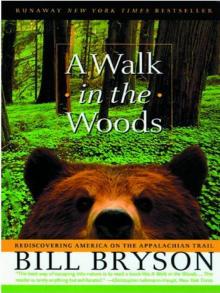 A Walk in the Woods
A Walk in the Woods I'm a Stranger Here Myself
I'm a Stranger Here Myself The Mother Tongue
The Mother Tongue Shakespeare
Shakespeare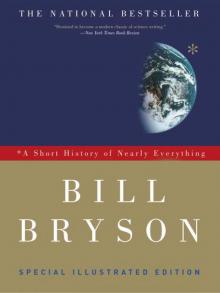 A Short History of Nearly Everything: Special Illustrated Edition
A Short History of Nearly Everything: Special Illustrated Edition The Best American Travel Writing 2016
The Best American Travel Writing 2016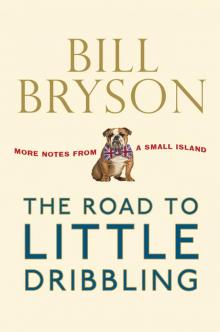 The Road to Little Dribbling
The Road to Little Dribbling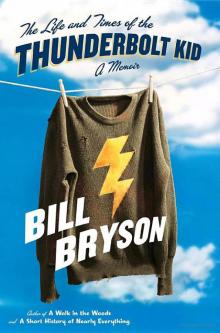 The Life And Times Of The Thunderbolt Kid: A Memoir (v5.0)
The Life And Times Of The Thunderbolt Kid: A Memoir (v5.0) Made In America
Made In America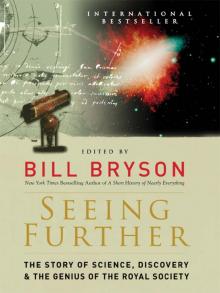 Seeing Further
Seeing Further Shakespeare: The World as Stage
Shakespeare: The World as Stage The Life and Times of the Thunderbolt Kid
The Life and Times of the Thunderbolt Kid At Home
At Home Bryson's Dictionary For Writers And Editors (v5.0)
Bryson's Dictionary For Writers And Editors (v5.0) Neither Here Nor There
Neither Here Nor There Bill Bryson's African Diary
Bill Bryson's African Diary